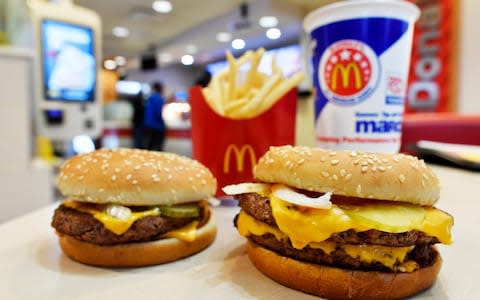KFC tried to make healthy(ish) food work and failed. So where has it gone down a treat and why?

It might not come as a huge surprise to hear that the popular fast-food chain KFC recently scrapped its plans for a healthier chicken dish after customers steadfastly refused to buy it.
Kentucky Fried Chicken, famed for its secret spice recipe which is kept under lock and key at the Louisville headquarters in the US, spent £8 million equipping its UK branches to start serving baked and grilled chicken, in an attempt to encourage healthy eating habits.
But after the failure of the company's Brazer grilled chicken sandwich in 2011, the Rancher sandwich in 2012 and the pulled chicken in 2015, it seems the public still has little interest in cutting back on calories – at fast-food joints, at least.
Granted, how often do you consider calories when contemplating a fast-food feast? It's often a treat, an indulgence. But in our increasingly health-conscious society, and with Public Health England threatening calorie counts in restaurants to tackle the UK's obesity crisis, businesses across the country are feeling the pressure to modify their menus.
Baked and grilled chicken isn’t the only health-conscious scheme hatched by the chicken connoisseurs at KFC; in what Jenny Packwood, the company's head of brand engagement, refers to as her “health by stealth” tactics, KFC has introduced a range of ‘rice boxes’, containing just one fillet of chicken alongside flavoured rice, beans and salad.
Speaking at Public Health’s England’s annual conference, Packwood explained that the boxes allow customers to eat “a little bit of what they love,” while consuming less fat, less salt and fewer calories than a standard KFC meal. A fillet rice box contains 490 calories, 2.7g salt and 14.7g fat, compared to a regular meal of four drumsticks and a side of chips, say, which contains 930 calories, 3.66g salt and 51g fat.
Other "health by stealth" attempts have been less successful. “We get a lot of grief about our fries,” Packwood admitted. Since late 2018, KFC has cut its chips slightly thicker to absorb less oil in the frying process. Though this reduced the number of calories per serving by 18 per cent and the amount of fat by 12, it didn't escape the notice of KFC devotees, with many taking to social media to express their outrage at the new recipe.
KFC’s new chips are stinking ☹️ bring back the old ones
— Libby (@LibbyyThomson) November 25, 2018
KFC isn’t the only fast-food outlet attempting to satisfy the health-conscious public. Burger King now offers salads (breaded chicken, a garden side salad, and apple slices) along with its flame-grilled Whoppers and Double Bacon XLs, while McDonald’s has sold salads since 2005, later introducing wraps and packets of carrot sticks and sliced apple. Happy Meals now come with a choice of water, organic milk and fruit juice, and chips can be swapped out for cucumber sticks and grapes.
According to a spokesperson for McDonald’s, these options have been received with open arms by customers. “We recently revamped our salad offering with a new recipe for our grilled chicken, and are pleased with how positively it's been received,” they told me. It’s a slightly different story when I visit my nearest branch, however...
“Once you’ve committed to a McDonald’s you’re in it for the bad stuff,” one man tells me as he places his order for a quarter pounder with cheese. “If I want something healthy, I’ll probably go to Pret or Leon,” says another, picking up a McChicken Sandwich with no lettuce.

Of the six people I meet in the queue (three men and three women), not one opted for a salad or a wrap. This isn’t to say that healthy options are a wasted effort, but it goes to show that no matter how hard a fast-food outlet tries, it will always, inevitably, generate associations of gluttony.
In the case of KFC (which states that, "in moderation, [its] food can be part of a balanced diet"), that specifically means fried chicken. Just as you wouldn't walk into a pizzeria and demand a cheese sandwich, strolling into the deep-frying specialist and asking for baked chicken does seem to, well, completely miss the point.
McDonald’s, on the other hand, can afford to diversify its offering because customers don’t go there solely for one thing. Burgers may rule the roost but there is the fillet’o’fish, the milkshakes and, favoured by children and adults alike, the chicken nuggets. In the mix, salads and – hell – even carrot sticks, have a place.
Choosing to ignore the nutrition klaxon altogether is Five Guys, the American burger bar chain that migrated to the UK with its first branch in 2013, and Shake Shack, another popular US import. Their menus comprise burgers, hot dogs, fries, milkshakes, and Shake Shack’s answer to the McFlurry, ‘frozen custard’ – a denser, richer take on an ice cream sundae. No healthy concessions here.

Yet queues snake out the door of my local Shake Shack – clearly salads can take a back seat. It’s worth noting, however, that the chain makes a point of mentioning the provenance of its produce, using 100 per cent grass-fed Aberdeen Angus whose source can be fully traced. It might not be the healthiest option but it gains kudos for sustainability.
Do we really want healthy options when craving chicken drumsticks and chips? The evidence suggests we don't, but having the choice at least enables customers to consider a balanced meal. I'll have a double cheeseburger with salty fries and onion rings, please. Salad can wait till tomorrow.
Have you ordered the 'healthy option' at fast-food restaurants? Or are they not worth putting on the menu? Share your experiences in the comments section below.
